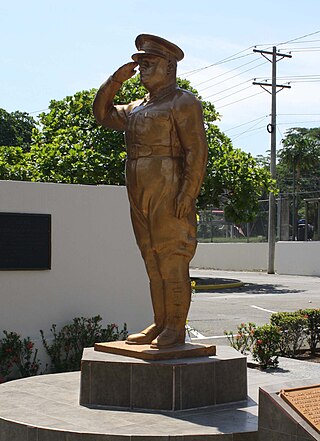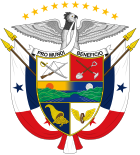
Arnulfo Arias Madrid was a Panamanian politician, medical doctor, and writer who served as the President of Panama from 1940 to 1941, again from 1949 to 1951, and finally for 11 days in October 1968.

Colonel José Antonio Remón Cantera was the 29th President of Panama, holding office from 1 October 1952 until his death on January 2, 1955. He was Panama's first military strongman and ruled the country behind the scenes in the late 1940s. He belonged to the National Patriotic Coalition (CNP), and was its candidate for president in May 1952.

Roberto Francisco Chiari Remón was the President of Panama in 1949 and from 1960 to 1964. He belonged to the Liberal Party.
José Ramón Guizado Valdés was the 17th President of Panama. He belonged to the National Patriotic Coalition (CNP).
Daniel Chanis Pinzón was Panamanian politician and physician. As First Vice President of Domingo Díaz Arosemena he became President of Panama on July 28, 1949, and served until November 20, 1949, when he was forcibly ousted by police chief José ("Chichi") Remón. He was succeeded by Díaz Arosemena's Second Vice President, Roberto Chiari. He belonged to the Liberal Party.

The Panameñista Party is a nationalist political party in Panama. It was the third largest party by number of adherents with 256,138 members.
Panama is a transcontinental country spanning the southern part of North America and the northern part of South America.

General elections were held in Panama on 10 May 1964, electing both a new President of the Republic and a new National Assembly.

General elections were held in Panama on 11 May 1952, electing both a new President of the Republic and a new National Assembly.

General elections were held in Panama on 11 May 1940, electing both a new President of the Republic and a new National Assembly.

General elections were held in Panama on 7 June 1936, electing both a new President of the Republic and a new National Assembly.

General elections were held in Panama on 5 June 1932 to elect a new President of the Republic and a new National Assembly. Harmodio Arias Madrid of the Liberal Doctrinaire Party (PLDo) was elected President, whilst the PLDo emerged as the largest party in the National Assembly, winning 14 of the 32 seats.
The Democratic Action Party was a Panamanian conservative political party.
The Third Nationalist Party was a Panamanian conservative, radical nationalist political party.
The National Patriotic Coalition was a Panamanian conservative nationalist political party.
The National Liberation Movement was a Panamanian right-wing liberal political party.
The Radical Action Party was a Panamanian small centre-right political party.
The Renewal Party was a Panamanian right liberal political party.
The Popular Union Party was a Panamanian centrist liberal political party.
Acción Comunal was a nationalist and anti-American political movement in Panama during the 1920s and 1930s. It was responsible for a coup on January 2, 1931, that deposed President Florencio Harmodio Arosemena.





